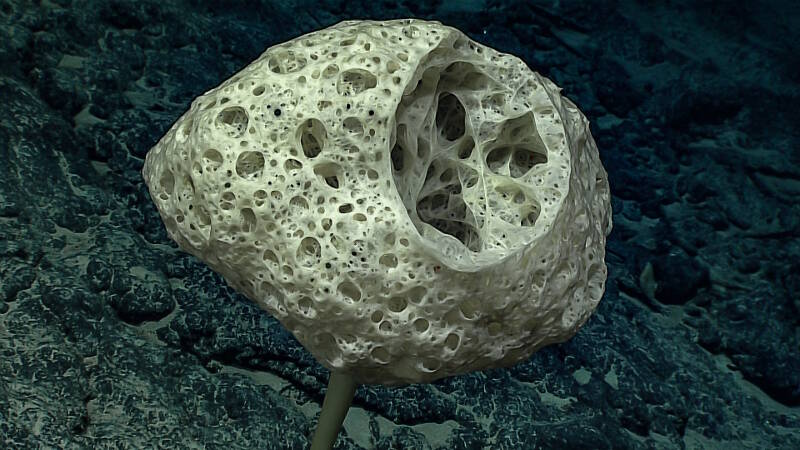
This Bolosoma stalked glass sponge may represent a new species. Image courtesy of the NOAA Office of Ocean Exploration and Research, 2017 American Samoa. Download larger version (jpg, 1.5 MB).

This Bolosoma stalked glass sponge may represent a new species. Image courtesy of the NOAA Office of Ocean Exploration and Research, 2017 American Samoa. Download larger version (jpg, 1.5 MB).
Dive 12: Bolosoma Sponge
Seen during Dive 12 of the expedition on Malulu Seamount, this Bolosoma sponge, with its unusual osculum (holes), is most likely a new species. Video courtesy of the NOAA Office of Ocean Exploration and Research, 2017 American Samoa. Download (mp4, 17.8 MB)
The twelfth dive of the expedition took place on Malulu Seamount, beginning near the summit at a depth of ~2,500 meters and moving up. Prior to reaching the summit, the substrate was mostly ferromanganese cobble welded to the seafloor, consistent with being either a volcaniclastic deposit or a talus deposit that has been covered with ferromanganese. During the dive, scientists were able to characterize dense sponge and coral habits on the slope and top of the seamount. Corals observed included Pleurogorgia and Chrysogorgia colonies, as well as bamboo whip and Bathypathes black corals. We saw several stalked sponges (Bolosoma and Callophacus) and we collected what may be a new species of Bolosoma. Many observed dead sponge stalks had ophiuroid brittle star associates. Brisingid seastars were common. We also observed and collected a goniasterid cookie star that is likely new species. Near the summiting ridge, we saw more abundant sediment with ripples, while the ridge top and right side exhibited very little sediment; based on these observations, scientists were able to identify the direction of predominant currents on the top portions of the seamount. The dive ended with exploration of the mid-water column, characterizing animals that live between 1,500 and 375 meters depth.